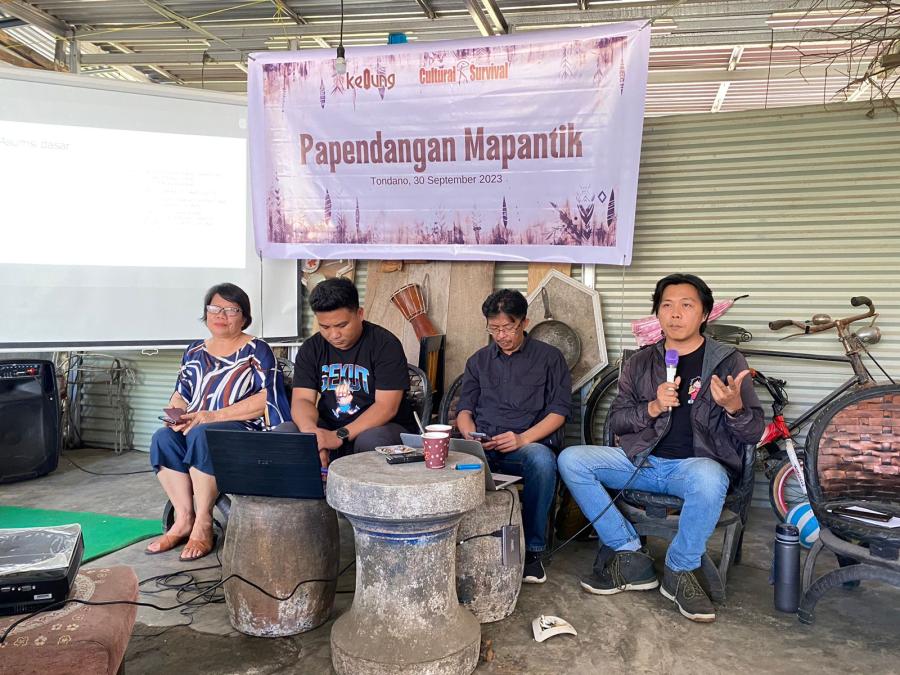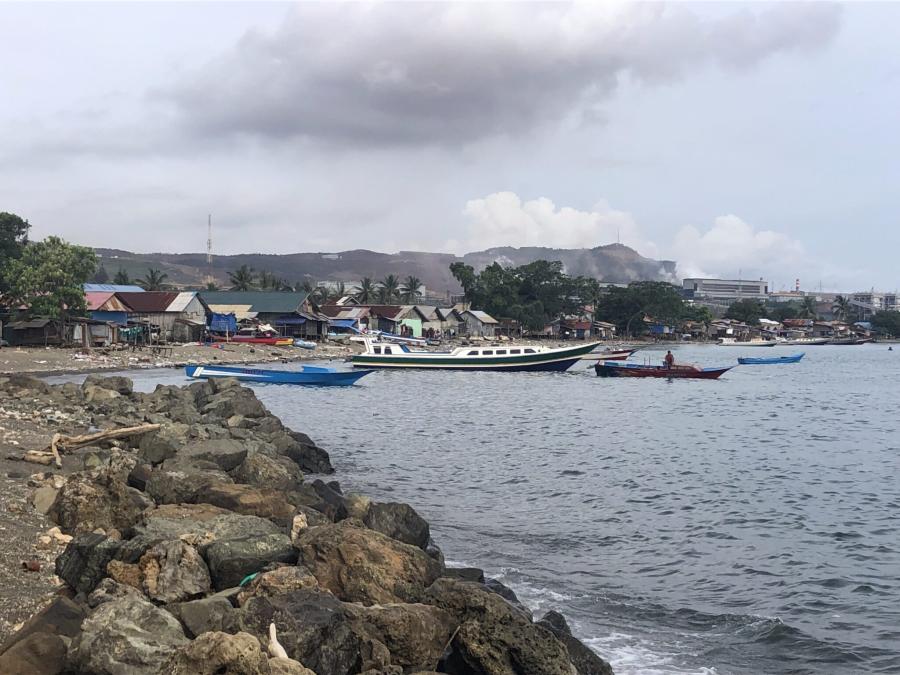The indigenous people of Siberut, part of the Mentawai Islands off Sumatra in Indonesia, are threatened by development. A Jakarta-based company, P.T. Sawit Asahan Indah, plans to convert Siberut's rain forests into oil palm plantation. In January 1990 company teams were surveying Siberut to map planting sites. One credible informant saw a planing map showing all of Siberut, except for a swath 12 km wide around the island's perimeter, designated for oil palm. A company representative supervising the survey teams said the extent of planting would depend on results of the surveys. The company has constructed two telecommunications towers in Siberut, one in the south at Muara Siberut, the other in the north at Sikabaluan.
Due to increased production and decreased international demand, the price of palm oil has plummeted in recent years. A major factor reducing the demand for palm oil in the US food industry has been publicity about this oil's high cholesterol content. The Siberut oil palm company still might run at a profit, however, by using free land and indentured smallholders imported from Java to grow the plantations. Also, the government is striving for increased consumption of palm oil within Indonesia, and decreased reliance on foreign markets.
"The Garden of Eden"
One of the first Europeans to comment on the Mentawai Islands was Sir Thomas Raffles. Visiting in the last century when he was vice-governor of Benkulu, he wrote, in a letter to the Duchess of Somerset in 1821, "I made further discoveries in these Islands, where I found a population more likeable still and, if possible, still more ingenuous. If I continue in this direction, I may expect somewhere to find the Garden of Eden, and descendants of our first parents."
Dutch army captain J.F.K. Hansen was of a different opinion. In 1917 he wrote, "Only he who is well acquainted with the pagan customs and the superstition of the Mentawai people will be able to understand how much sacrifice, charity and moral courage was needed here to keep up the fight against paganism." This fight against "paganism" was conducted by German Lutheran missionaries. The first of these, the Reverend Mr. Lett, settled at Nemnemleleu, North Pagai, in 1901. In 1912 he was killed by villagers in South Pagai. According to legends still told, the villagers resented Lett's calling them his "children."
In 1916 the first islanders were converted to Christianity by Lett's successor, the Reverend Mr. Boerger. As Boerger described it, "We went into the village [on North Pagai] to the house of Roerasabeoe, where the whole family had gathered. We prayed and recommended them to the living God, who wished to take them and their house into His merciful protection. Then without fear or reserve the disposal and burning of the idols began... When everything had been disposed of, we prayed again for the blessing of the Lord, and next we went to the other family where everything passed the same way."
A Culture Is Christianized
Thus began the planned, systematic destruction of Mentawai culture. Christianization has destroyed old animistic practices that once maintained harmony between people and their environment in the southern Mentawais. Only in remoter parts of Siberut has original culture survived relatively intact, at least partly because Christianization there was delayed. In 1956 Catholic priests from Italy opened the first mission in Siberut. Recent missionaries have been more appreciative of Siberut culture than earlier ones were. Italian priests wear shaman beads while saying mass, and they join Siberut fetishes to Christian crucifixes.
Indonesian authorities have continued destructive policies started by early missionaries and the Dutch government. In 1980 the district administrator (the camat) in charge of the southern half of Siberut ordered that all traditional ceremonies be stopped and that all shamans hand over their traditional religious paraphernalia. Enforced for a while, that order since has been rescinded. Local authorities, and Siberut's monetary economy as a whole, profit from foreign tourists drawn to see the colorful remnants of Siberut's dying culture. Because they attract tourists to Siberut, shamans once again are free to practice traditional rituals in traditional garb. But just as there is no forest in Siberut that has not been altered by humans, no adult islander remains unchanged by exposure to outsiders and desire to outsiders and desire for commodities from the industrialized world. Even in Siberut's remotest settlements, people want wristwatches and radios.
Many - especially among the elderly - still treasure traditional culture as well. Aman Nuisak, the aging leader (rimata) of Siberut's Sakuddei clan, said, "My children are not like me. I wanted to tattoo them, and they refused. They want to be modern. If that's what they want, it's fine with me. But I like my tattoos and my loincloth. I am Mentawai until I die." The Sakuddei are one of the few Siberut clans still living in the traditional settlement pattern: a ceremonial longhouse (the uma) by the river, with family houses scattered up and downstream from it. During ceremonial periods called punen, the entire clan stays at the uma. Otherwise, just the rimata and his immediate family live there - very different from the densely packed villages started by the Dutch.
The 70-year-old Dutch-instituted policy of resettling people from Siberut's interior to villages along the coast or large rivers still is applied. It forces many people to live far from their gardens, which are then likely to be destroyed along with the rain forest if the oil palm project is realized. These crowded villages with no sanitary facilities also promote the spread of disease. For example, from August to November 1989 there was an outbreak of dengue hemorrhagic fever at the government-established village of Lubaga in northern Siberut. After six adults and 50 of the village's 75 children died of the disease, the survivors fled to their widely dispersed garden houses. In the late 1970s an epidemic of cholera similarly wiped out the village of Simatalu, also crowded by edict. Unhealthy congesting of villages may intensify if people are displaced to make room for palm plantations. If the sago palms that provide Siberut's staple food are replaced by oil palms, some islanders might have to be fed by the government or starve. Pigs and chickens, also raised on sago, will decrease. Increased erosion from deforestation will denude land, clog streams, and smother coastal coral reefs.
No organization has yet made a long-term commitment to preserving the culture or environments of Siberut. In 1980 the World Wildlife Fund (WWF) published a report entitled Saving Siberut: A Conservation Master Plan. Page 77 of that report states:
In this plan, conservation is used to help meet the needs of the people, showing how man can live in sustainable balance with the resources available to him. The conscious use of conservation techniques for sound socio-economic development is a new approach which needs to be constantly analyzed, evaluated, and modified as needed; once it has been shown to be worthwhile in practice in Siberut, the approach will have broad applications elsewhere in Indonesia.
WWF persuaded the Indonesian government to declare a nature reserve in Siberut. It stationed an American anthropologist in Siberut from 1980 to 1982 to continue working on the conservation plan. In 1981 Siberut was declared a UNESCO Biosphere Reserve. WWF pulled out in 1982, and no provisions were made to protect the nature reserve. The nature protection branch (PHPA) of Indonesia's national Forestry Department lacked the personnel, funds, and motivation to protect it on their own. Commercial logging currently is conducted in the reserve - a small problem compared to converting the reserve to oil palm plantation. UNESCO's Biosphere Reserve apparently was forgotten.
Survival International also was involved. It brought a few water buffalo and the idea of culturing freshwater fish for food. It prepared recommendations on how economic development should proceed. Then, like WWF, Survival International left. If health was improved it is not evident. According to resident missionaries, in the 1980s only one of every four children born in Siberut survived to adolescence. This is the same preadult death rate that was recorded in Siberut by German missionary Helmut Buchholz in the late 1960s and early 1970s.
Efforts to prevent debasement of native people and natural environments of Siberut must involve frequent visits by outside observers and a long-term commitment of outside funding. West Sumatra's Andalas University could be the center or collaborative efforts to study and monitor socioeconomic and biotic conditions in Siberut and the rest of Mentawai. A similar suggestion was made in WWF's conservation plan.
In the early 1970s, when commercial logging began in Mentawai, the people of Siberut were expressing anger that their trees were being taken away. But now they say little about the proposed oil palm plantations, which could destroy their livelihood. One man said to me, "The government is strong and we are weak, what can we do? How about you, could you stop this oil palm?" Only the government of Indonesia can do that.
References
Hansen, J.F.K.
1917 De eerste kerstening der Mentaweiers. Tijdschrift voor het Ninnenlands Bestuur 52:19-31.
McNeely, J.A. and P.S. Wachtel
1988 Soul of the Tiger. New York: Doubleday.
Schefold, R.
1988 Lia: Das Grosse Ritual auf den Mentawai-Inseln (Indonesien). Berlin: Dietrich Reimer Verlag.
Tenaza, R.R.
1989 Primates on a Precarious Limb. Animal Kingdom 92:26-37.
World Wildlife Fund
1980 Saving Siberut: A Conservation Master Plan. Bogor Indonesia: World Wildlife Fund.
How You Can Help
If you have information or ideas that might help, please write to the author. You also may wish to express your concerns in courteous, respectful letters to President Suharto. Siberut's culture, rain forests, and wildlife are Indonesian national treasures - and irreplaceable treasures of the Earth. In a moment they could be gone.
Richard R. Tenaza
Biological Sciences Department
University of the Pacific
Stockton, CA 95211
President Suharto
Instana Merdeka
Jakarta Pusat
Indonesia
Article copyright Cultural Survival, Inc.



